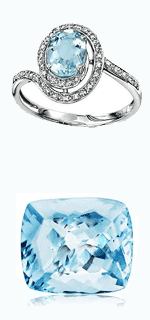| Colors: |
Like seawater, aquamarine comes in light blue, dark blue, blue-green and green-blue color. The more saturated the color, the higher the value, although almost all aquamarine is typically a lighter blue tone. A deeply saturated blue is the most desirable color, but it is very rare in larger specimens. |
| Shapes: |
Aquamarine is available in both faceted and cabochon cuts. The most favored cut for Aquamarine is an emerald step-cut; the most common cuts are traditional shapes such as round, pear, oval and cushion. |
| Origin: |
Brazil, Australia, Myanmar (Burma), China, India, Kenya, Madagascar, Mozambique, Namibia, Nigeria, Pakistan, Zambia, Zimbabwe, as well as in several U.S. locations. |
| Care: |
Should be immersed in jewelry cleaner or lukewarm soapy water and cleaned with a soft bristle brush. Protect from scratches and sharp blows. |
| Notes: |
The Romans used the aquamarine for diseases of the stomach, and believed it could cure liver and throat troubles. |

